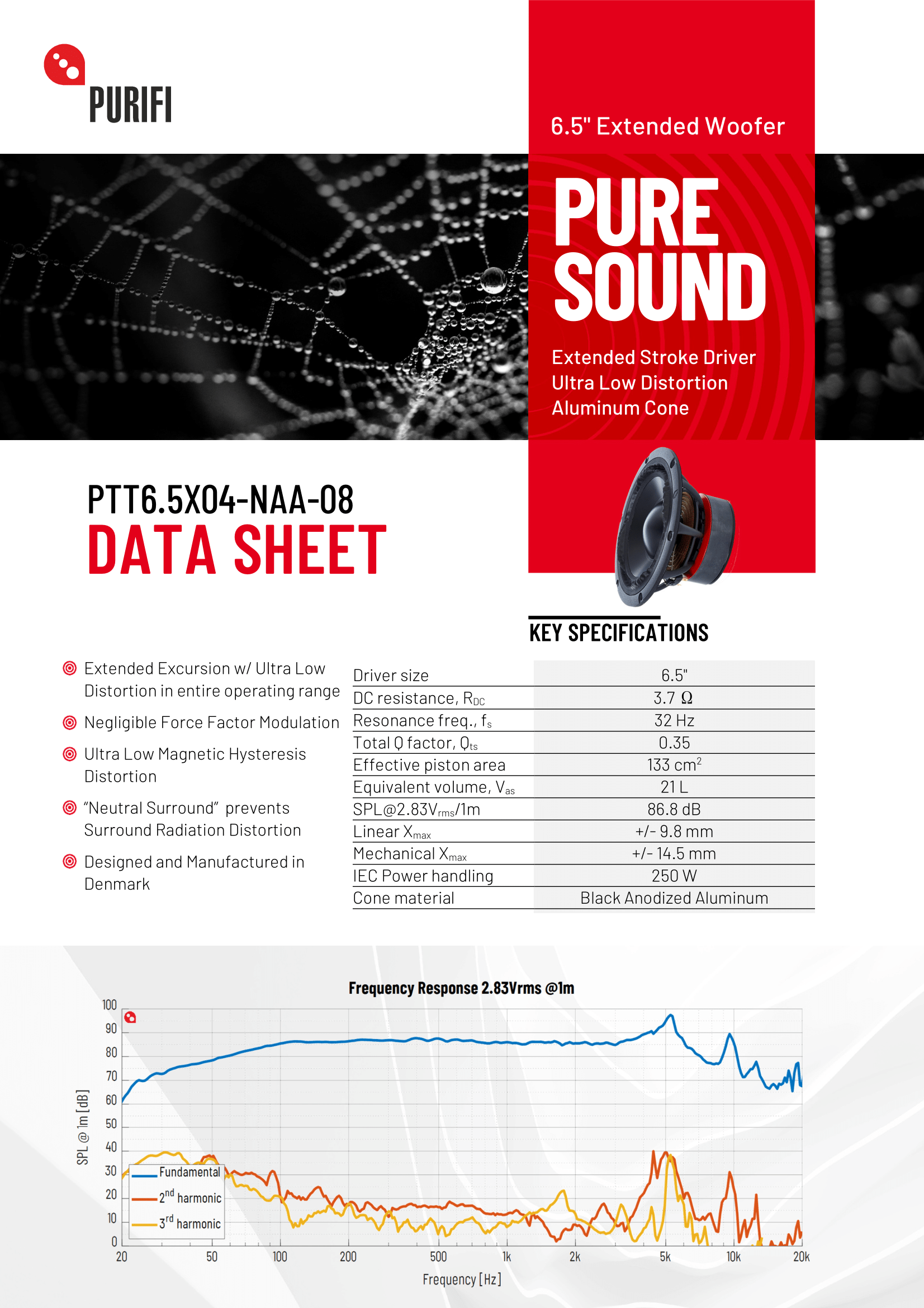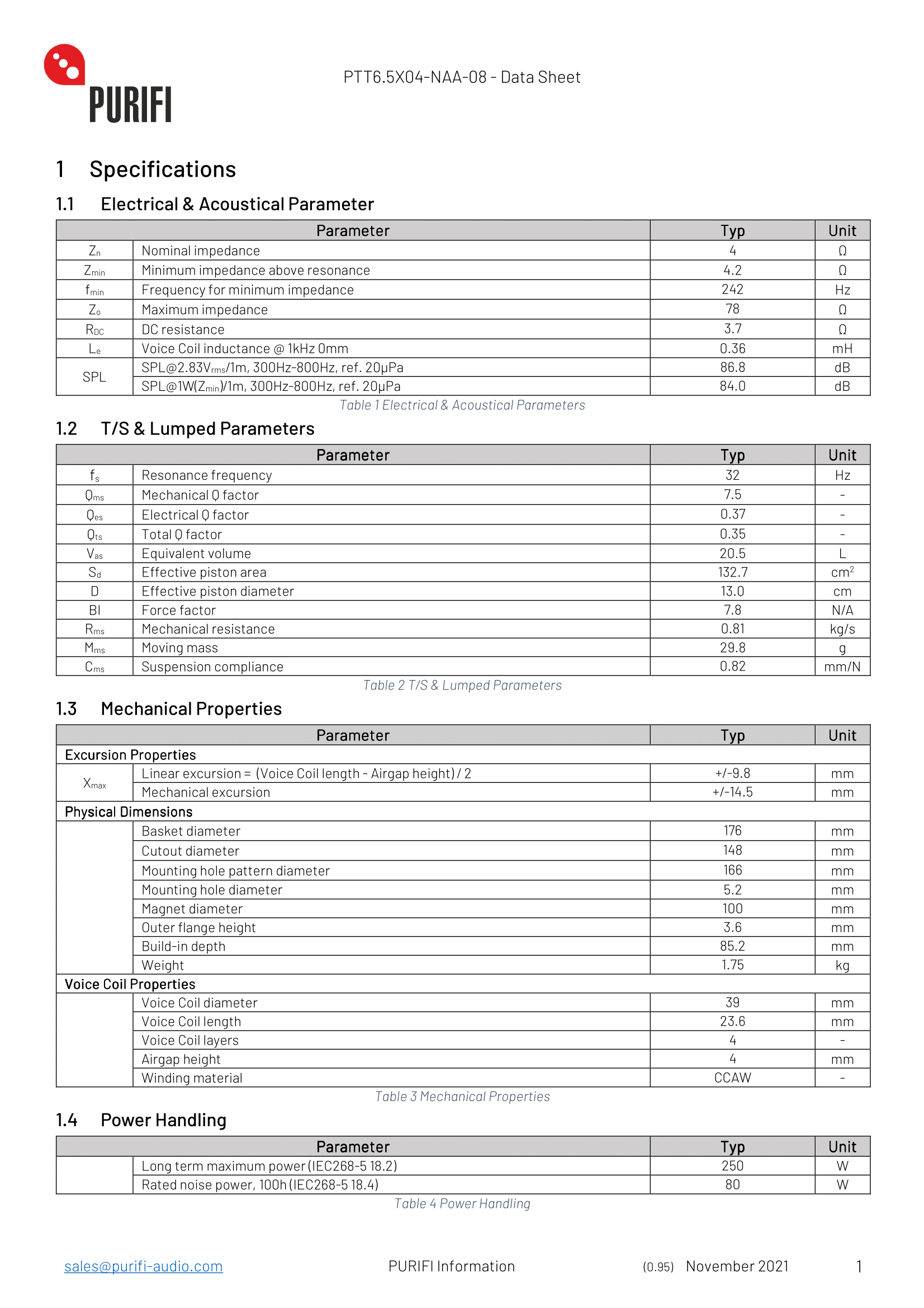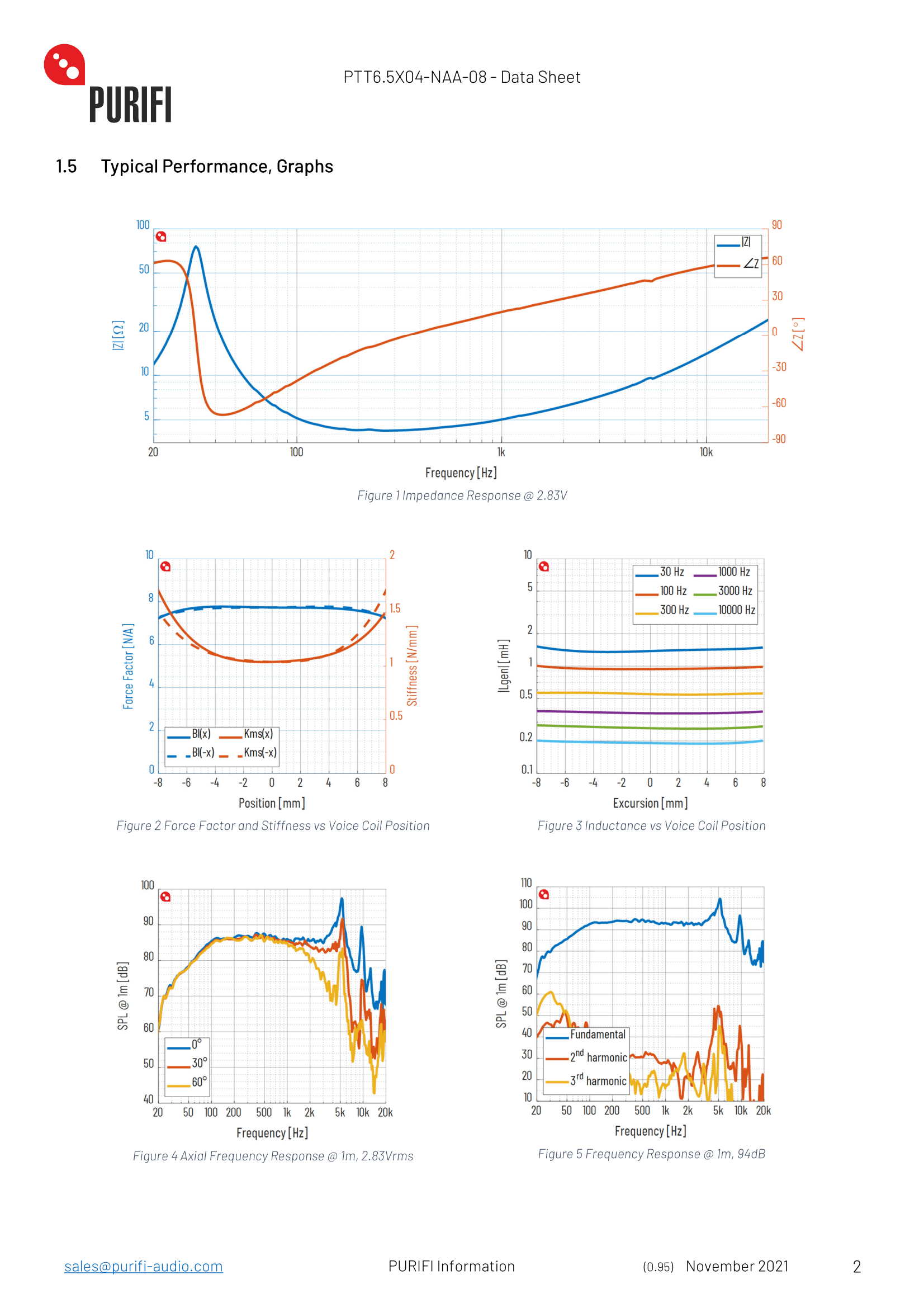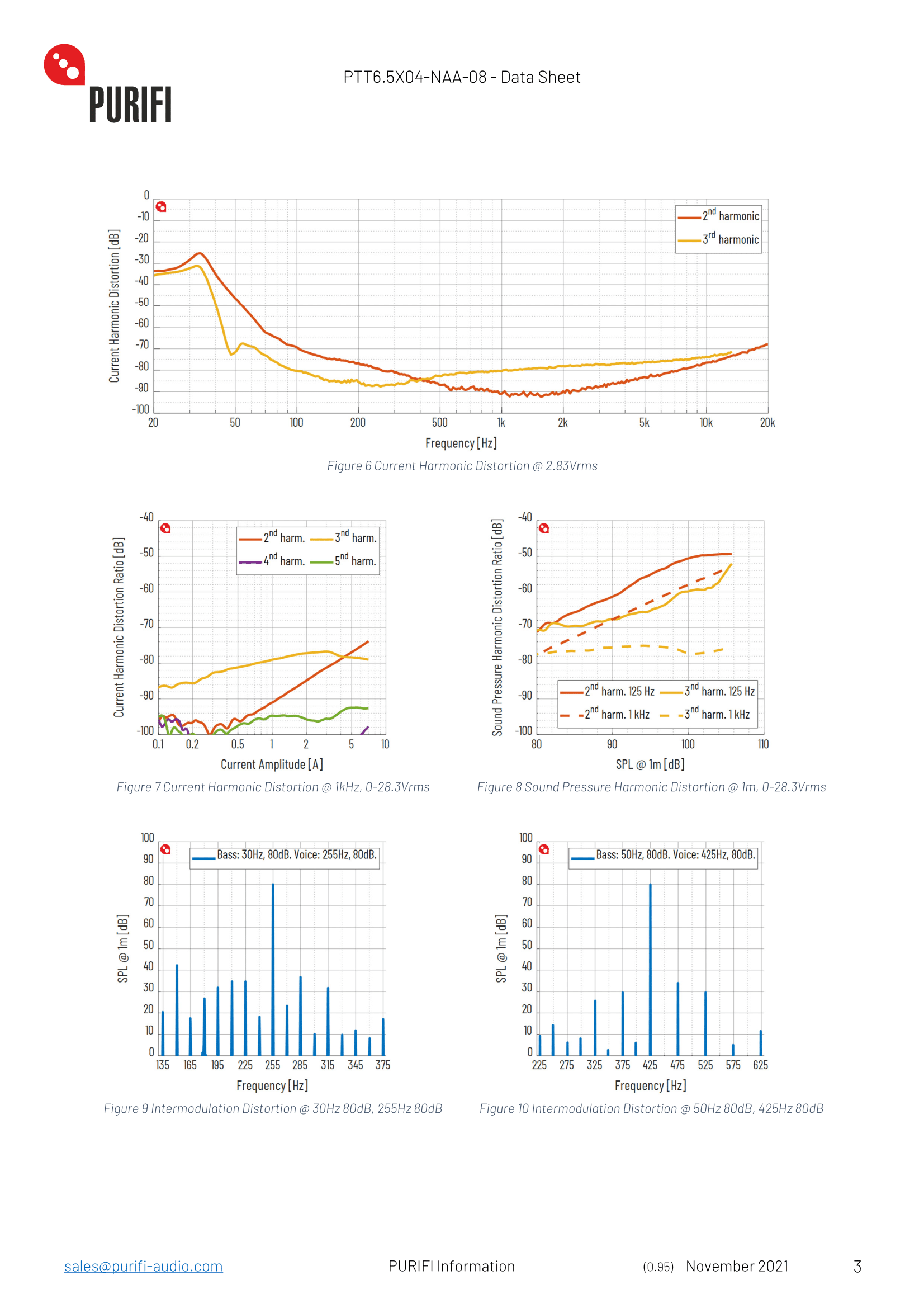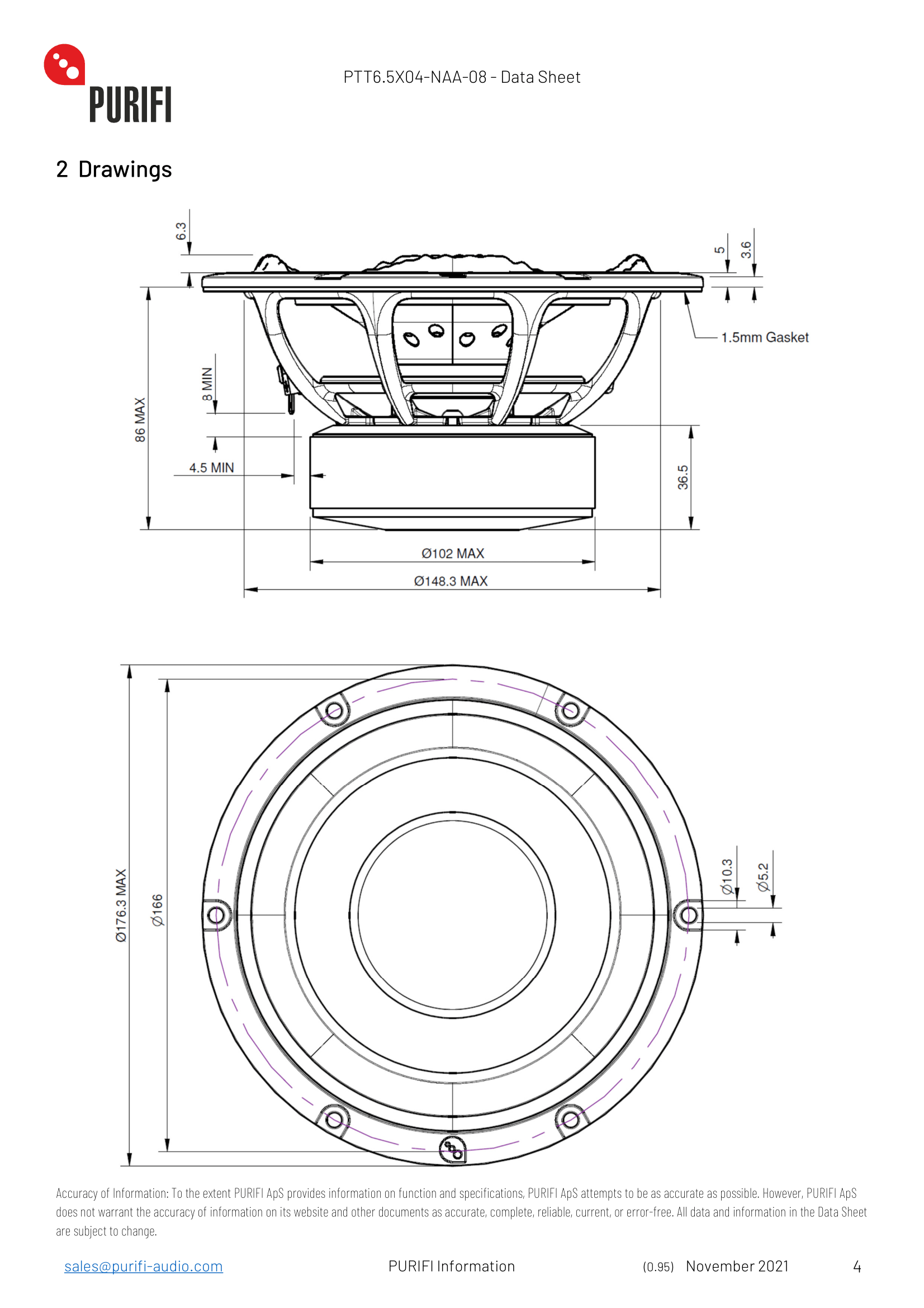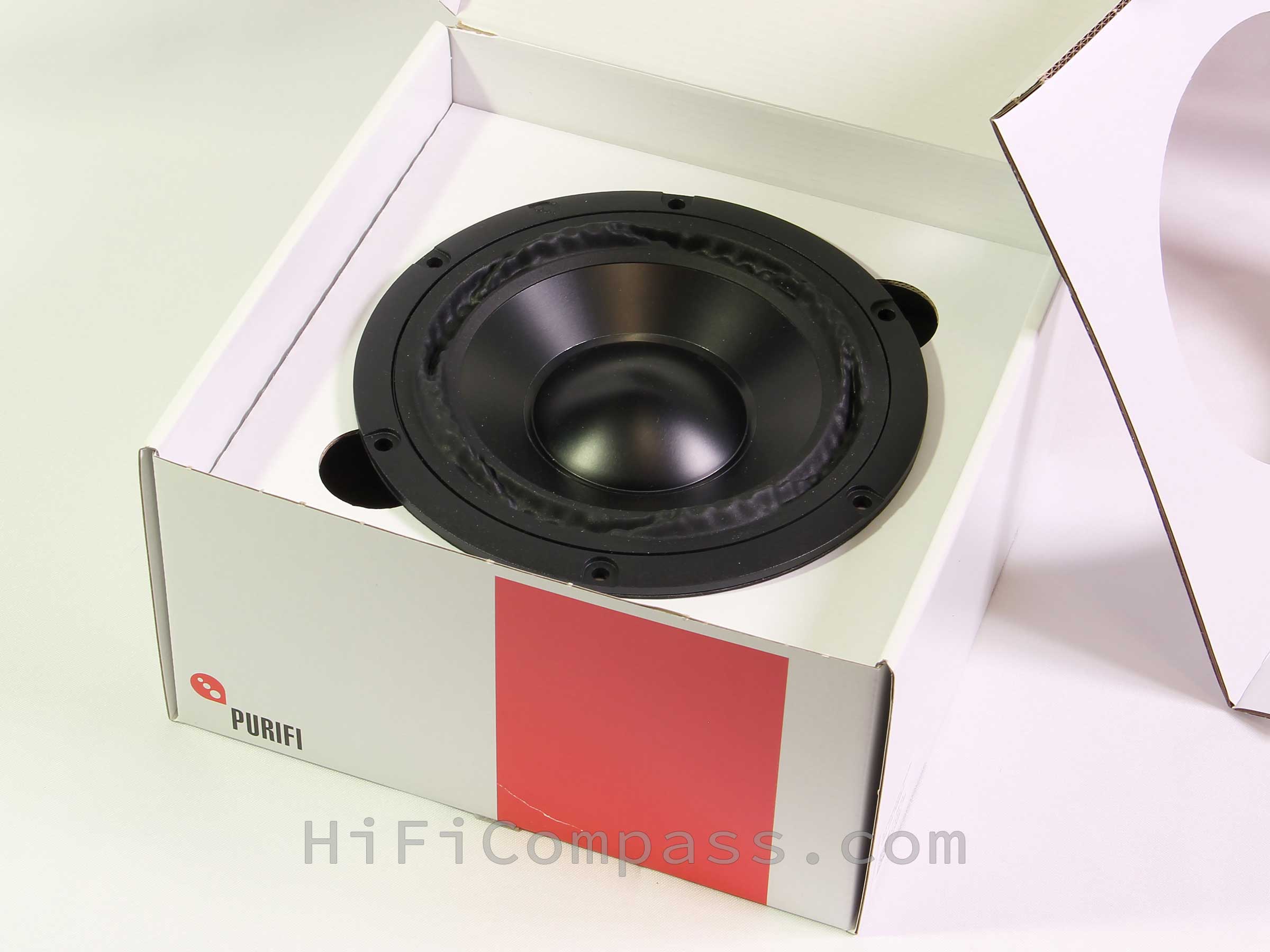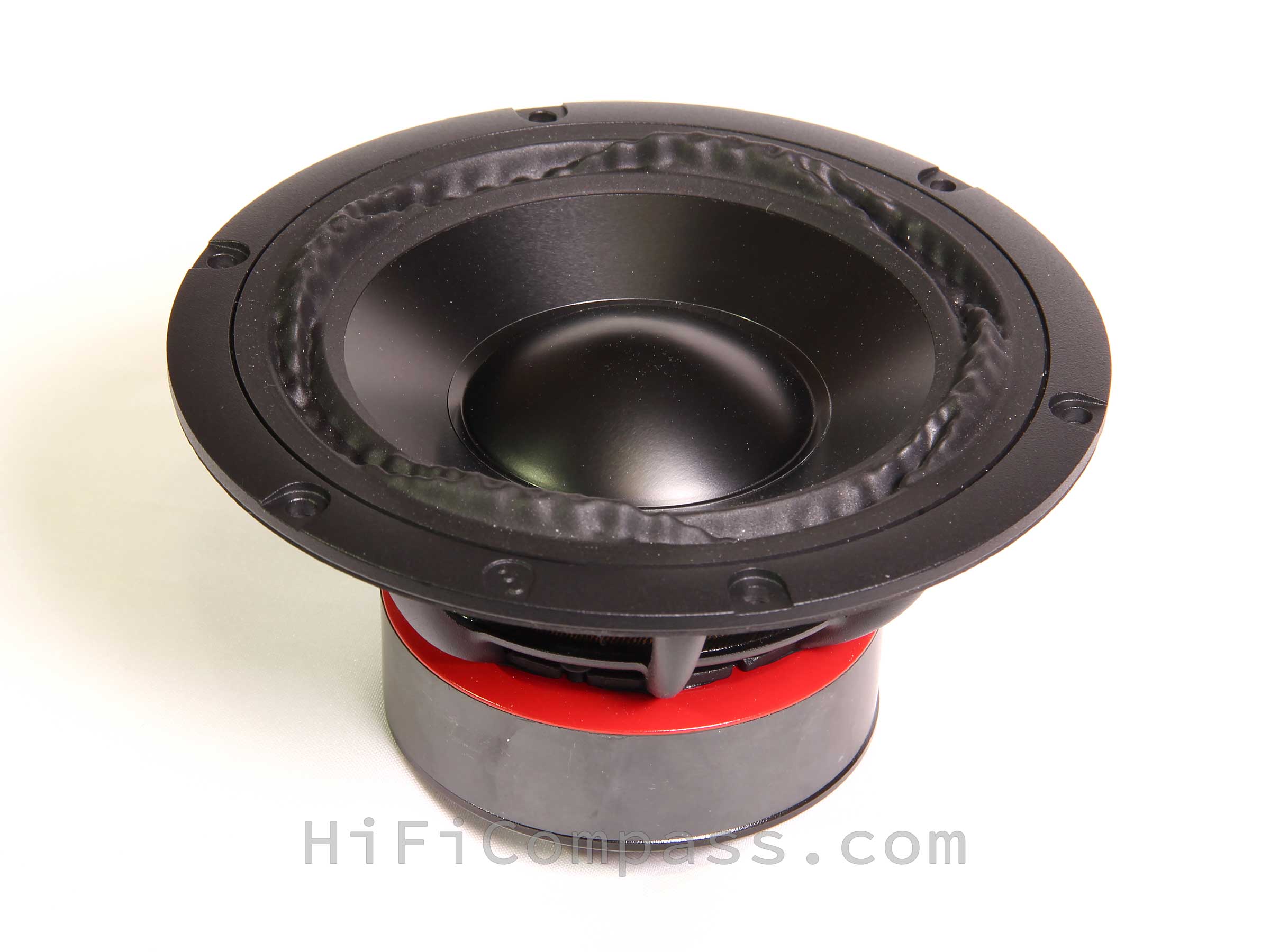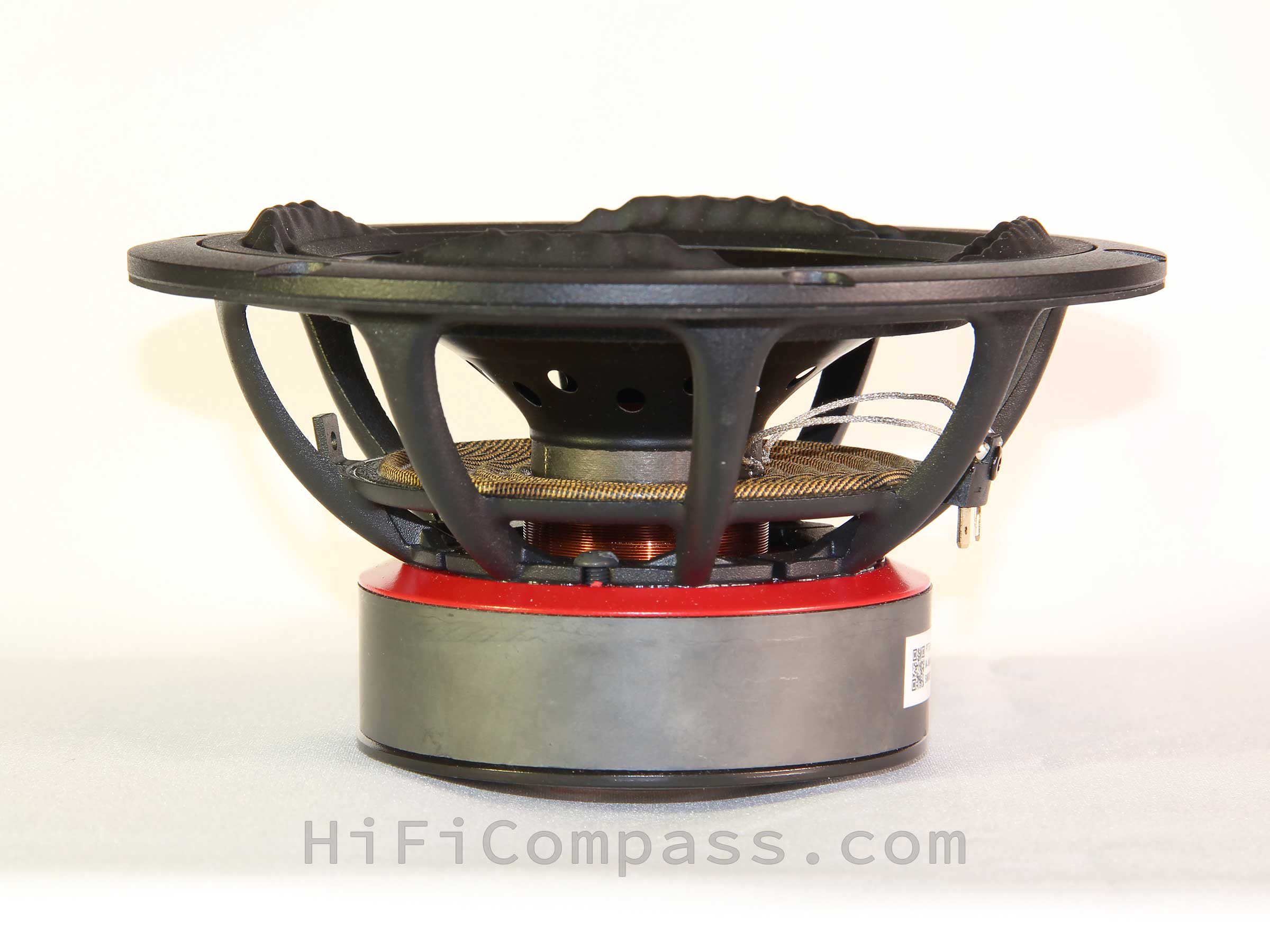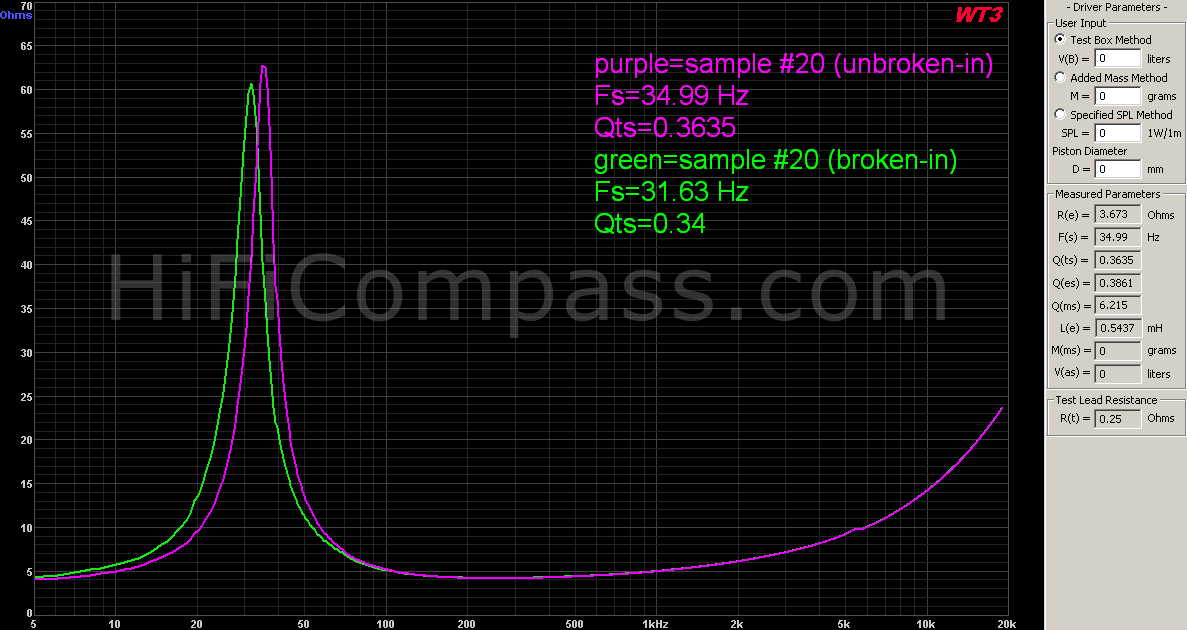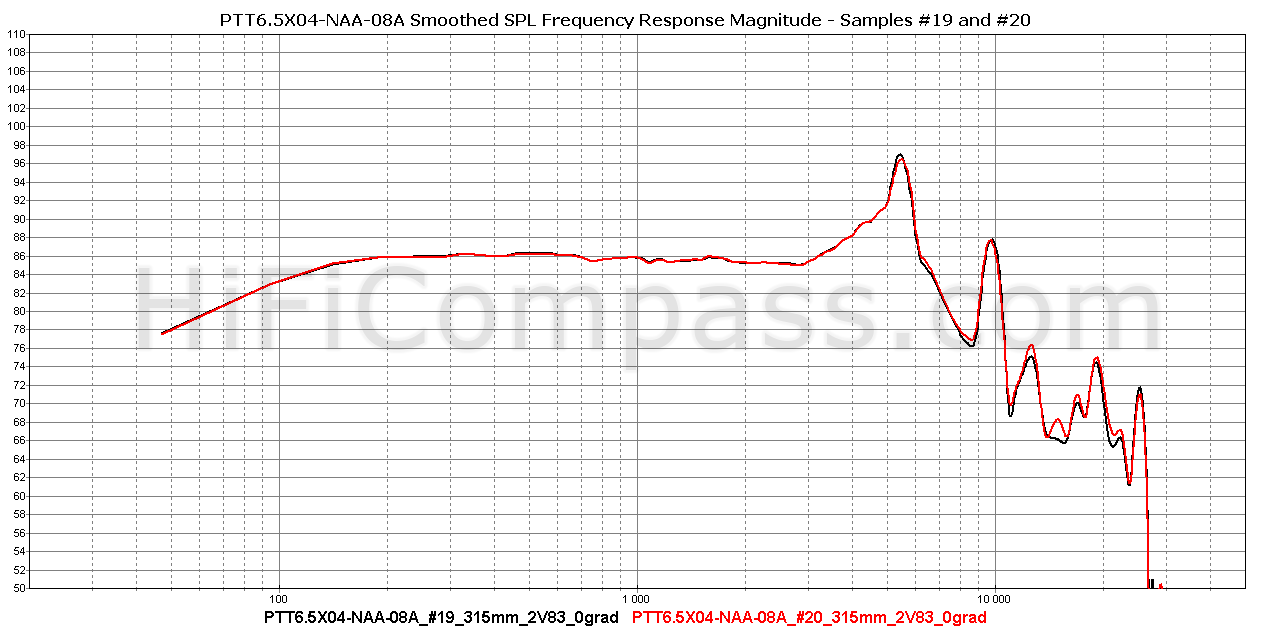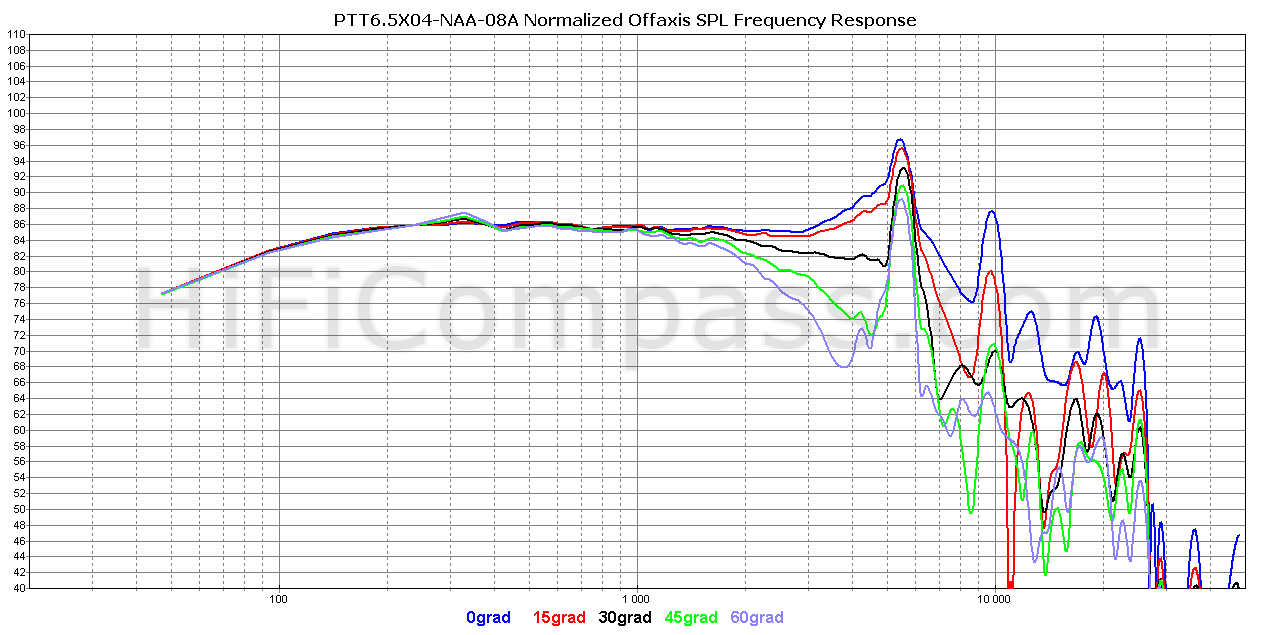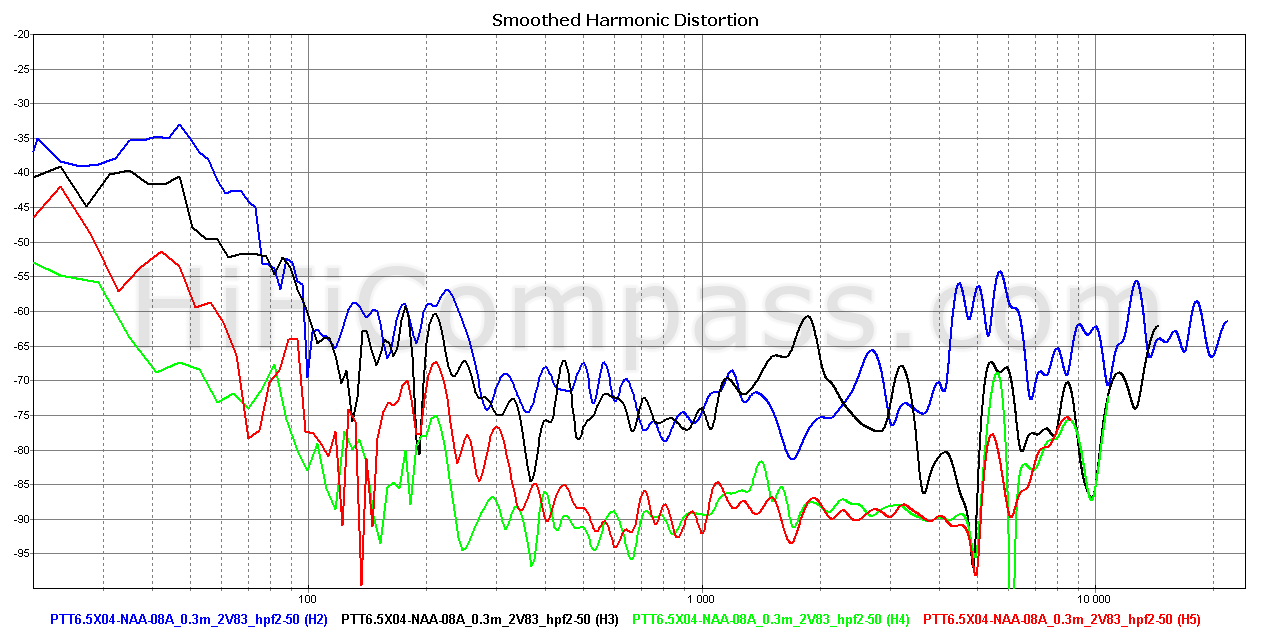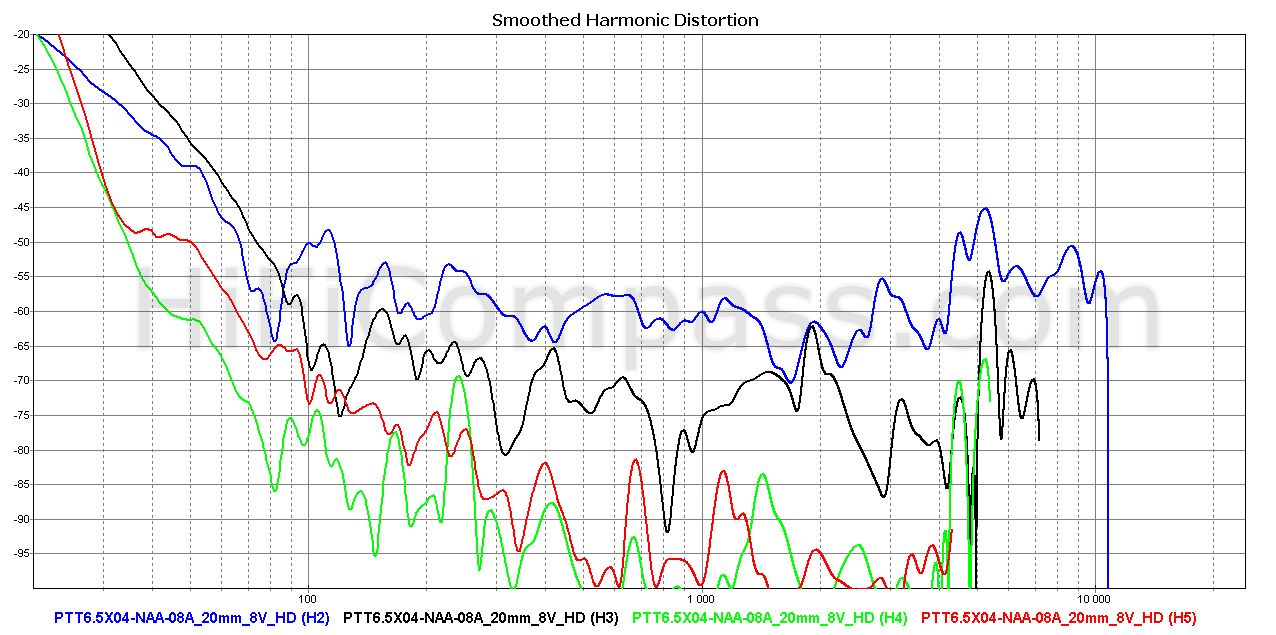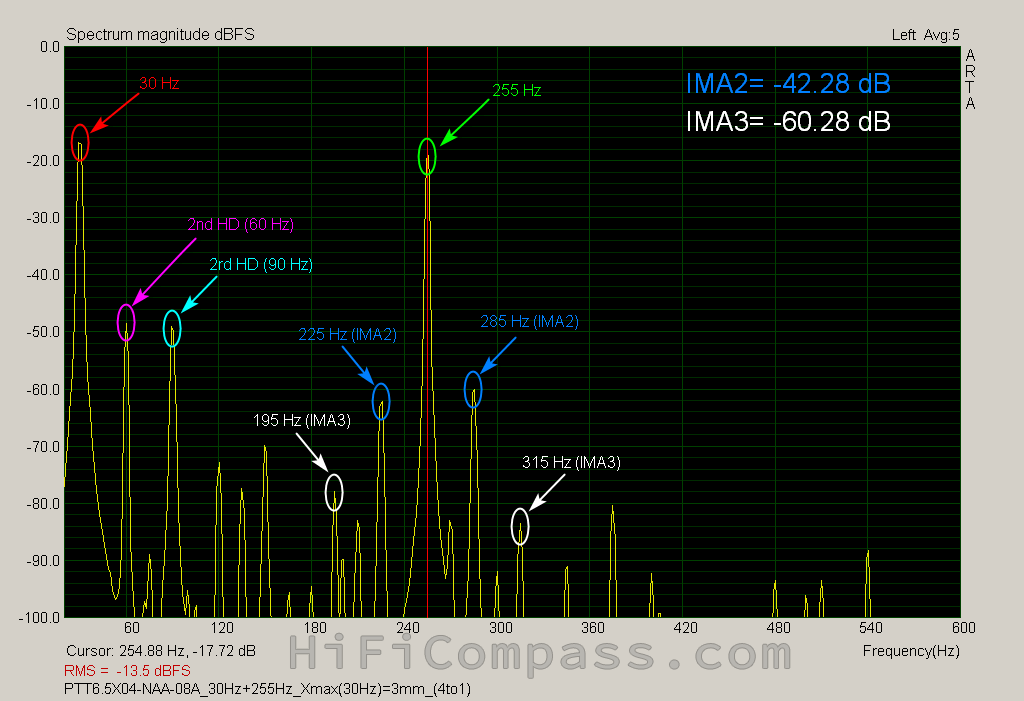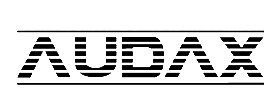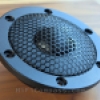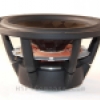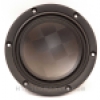HiFiCompass
Purifi PTT6.5X04-NAA-08 6.5" Alu midwoofer
What is on the test bench?
The Danish company PURIFI continues very confidently march to the Olympus of High-End speakers and seems has squeezed everything out of its line of 6.5" speakers with paper cones, bringing them to perfection. First, the company has produced PTT6.5X04-NFA -01 (Xlin=+/-9.8 mm), then its normal stroke version PTT6.5W04-NFA-01 (Xlin=+/-5.9 mm) and the lower moving mass midrange short-stroke model PTT6.5M08-NFA-01 (Xlin=+/-2.9 mm). In addition, another engineering step has been done with the introduction of an updated and improved basket for all 6.5" models. Where to go next?
Next logical step in the development of the line suggests itself - to try new membrane materials, same as many speaker manufacturers do. The new direction in the company development quickly reached the goal and here is the result - on the table in front of me lies the first model with an aluminum cone, which was announced in September, 2021. It is the 6.5" long-stroke midwoofer PTT6.5X04-NAA-08.
Aluminum is an extremely popular material for speaker membranes all over the world, from subwoofers to tweeters. It combines all the necessary features to be popular and successful - lightness, rigidity, manufacturability and low cost. It would be a shame not to try it!
You can read the history of the PURIFI company here.
Why do we test this?
Being very familiar with some Alu cone 6" midwoofers (Dayton Audio RS180-4, SEAS L18RNX/P, SB Acoustics SB17NBAC35-8), I was very interested in how this material could be implemented on the PURIFI motor.
Midwoofer PTT6.5X04-NAA-08A was kindly provided for testing by PURIFI. I would like to express my deepest gratitude to the company, as well as personally to its members Lars Risbo and Claus Neesgaard for time spent discussing technical aspects related to the design and technical solutions implemented in the speaker driver.
What did the manufacturer state?
PURIFI has the most detailed and informative datasheets of any company I know of. In them you can find everything you need to design loudspeakers and even more.
In addition to very familiar plots of the axial SPL frequency response and the impedance frequency response, the following have been added:
- Force Factor and Stiffness vs Voice Coil Position
- Inductance vs Voice Coil Position
- Current Harmonic Distortion @ 1 kHz, 0-28.3 Vrms
- Sound Pressure Harmonic Distortion @ 1 m, 0-28.3 Vrms
- Intermodulation Distortion @ 30 Hz 80 dB, 255 Hz 80 dB
- Intermodulation Distortion @ 50 Hz 80 dB, 425 Hz 80 dB
Of the parameters and characteristics of the midwoofer, the following should be noted:
- Four-layer voice coil
- The voice coil inductance of 0.36 mH - very low value for a four-layer coil
- High mechanical quality factor of Qm=7.5
- Low sensitivity - 86.8 dB/2.83 Volt*1m
- A linear stroke of 9.8 mm (!) at one direction - is a very high value, a really long-stroke midwoofer
- Very long voice coil - 24 mm
- The moving mass Mms of 29.8 grams is the largest among all 6.5" PURIFI midwoofers at the moment. Here it has become three grams higher compared to the paper version. Many people are skeptical if a midwoofer with such a high mass can reproduce a mid range with high quality. From my personal experience for more than two-year with the paper version of PTT6.5X04-NFA-01 in the two-way loudspeakers PuriBliss-BeWg and PuriWave, I can say that it for sure can and does it very good! Moreover, the experience of numerous owners, that has already been accumulated all over the world since the appearance of these midwoofers, also clearly indicates the complete failure of such a skepticism.
Visual inspection
- Packaging - durable packaging made of harde glossy cardboard with two-color printing. Inside the box, the speaker is fixed with cardboard inserts around the basket and polyethylene foam around the magnet
- Workmanship - all at the highest level. No traces of glue, scratches, dirt or dust, spots and dents on the cone, chips on the ferrite magnet, gaps and skewness anywhere. There is nothing to complain about
- The basket - is aluminum alloy diecast with black microtextural powder coating. Acoustically very transparent. It is fixed to the magnet system by glue and four screws.
An interesting detail - the basket base, which is attached to the magnetic system, has a form not like a continuous ring, as in majority of other speakers, but has cuts between the ribs. The thing is that a solid basket base forms a short-circuited loop, which introduces asymmetry into the magnetic field at a large voice coil stroke, therefore to eliminate this effect the ring here was made split. Even this seemingly small detail was given attention during the development -
The top and bottom flanges of the magnetic system are made of metal and painted one in black - I believe, to improve heat dissipation, and another in red for an attractive visual appearance
- The magnet is made of ferrite, nothing special here
- The surround is very unusual. It is made of NBR rubber and in its shape resembles alternating mountain ridges. The four ridges look outward and other fours inward. The surround is absolutely symmetrical relative to the basket flange plane. This is the principle of PURIFI Neutral Surround - it is symmetrical, unlike conventional half-roll surround, so the effective radiation area remains constant throughout the entire voice coil excursion. In traditional half-roll surrounds the radiation area increases during the inward voice coile movement and decreases when moving outward, introducing additional nonlinearity.
-
The cone is made of aluminum and is protected from corrosion by deep anodizing in black with a pleasant silky semi-gloss sheen. The profile of the cone has a barely noticeable curvature. On the side of the neck, the cone has many holes for ventilation of the space under the dust cap.Also, as in the paper version, a paper stiffening rib of a triangular profile is glued along the edge of the back side of the cone. This helps increase the stiffness of the cone and combat the well-known "cone edge/surround" resonance
- The lead wires are silver plated
- The terminal block looks worthy and matches the status of the speaker. It is made of thermosetting plastic with gold-plated knife terminals molded into it
- The spider is made of BIMAX material. BIMAX is known for its durability and increased resistance to mechanical stress. As a rule, it is used in top models of speaker drivers
- The voice coil former - is made of fiberglass. It is also a very popular non-conductive material, which allows to avoid additional losses from eddy currents, as in the case of aluminum formers, and to maintain high mechanical quality factor of the moving system. The former doesn't have ventilation holes.
- The voice coil is very long, 24 mm, and protrudes noticeably out of the magnetic gap. The coil is four-layered and wound with copper clad aluminum wire (CCAW) with variable pitch, which is one of the secrets of obtaining high linearity of BL(x) and Le(x) over the entire excursion range.
The midwoofer PTT6.5X04-NAA-08 got an updated basket, which the company has now brought to perfection. Here's what's been upgraded:
- The new basket has become noticeably more massive, they didn't spare the material this time, and much more inert compared to the previous version, which seemed flimsy to me. Now all the critical elements have become thicker and stiffer, and the mounting flange has got rid of the “stingy” cavities on the back side and has become solid in cross section. A very correct decision!
- The foam rubber gasket is glued to the back of the basket at the factory - a trifle, but nice, because you don’t have to do it yourself.
- The terminal block is attached to the bracket, which in the new basket has changed its angle in such a way that the attachment to the terminals has become much more convenient and the magnet now does not interfere.
- The ring platform for the spider has become a few millimeters lower, that is, further from the basket flange. Due to this, the attachment point of the surround and the spider became further apart, which contributes to a more stable position of the voice coil in the gap and reduces the “rocking” of the moving system. In addition, a few millimeters freed under the neck of the cone made it possible to change the point of attachment of the lead wires from the cone to the voice coil former, which I consider more reliable and correct.
All subsequent speaker models will now be equipped with a new basket. This circumstance must be taken into account when designing loudspeaker enclosures, since the minimum opening for the new basket has increased from 145 mm to 148.3 mm.
So, we see an excellent top-class design, already well known from previous reviews, but with a significantly improved basket.
Impedance frequency response
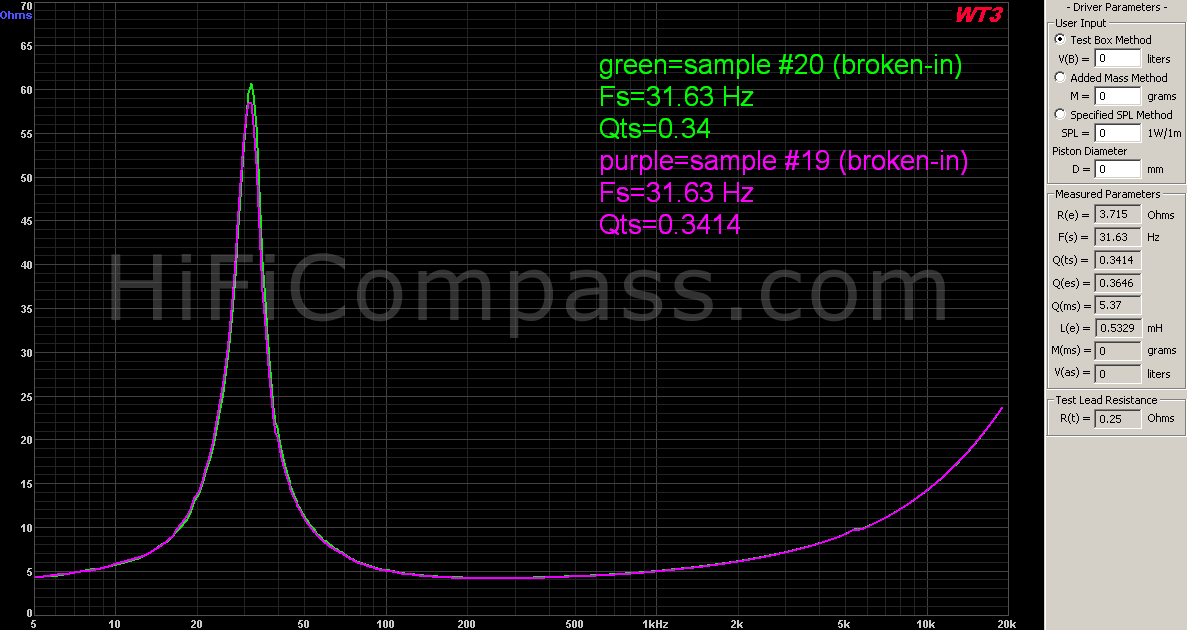
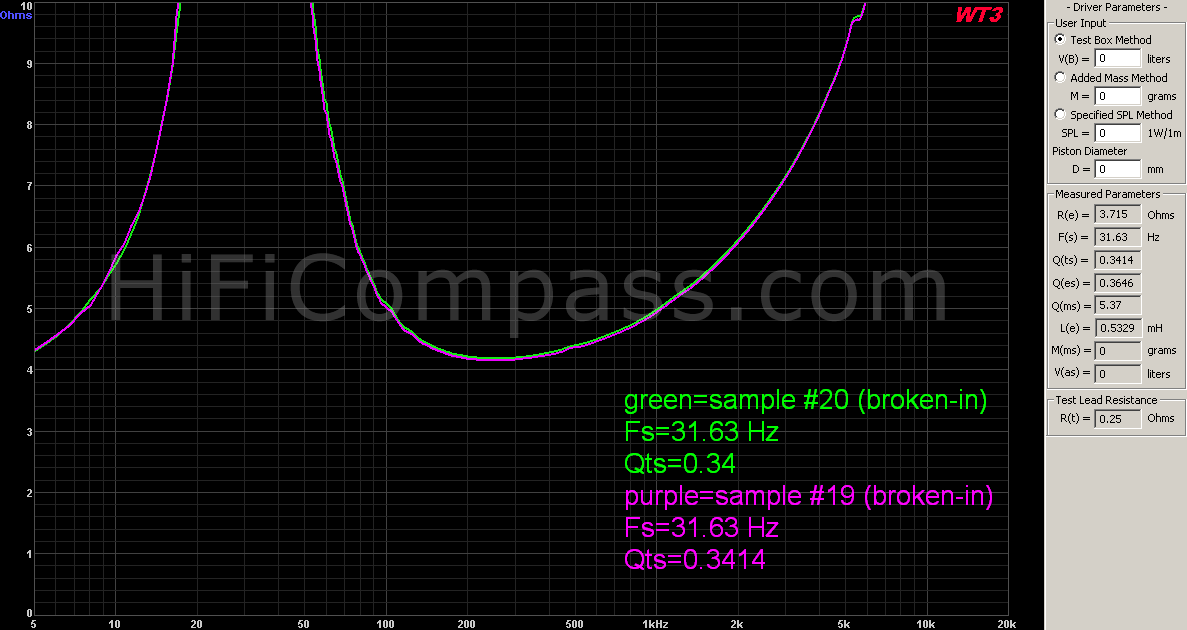 The first graph shows the midwoofer's impedance curves before and after they are broken-in. Purple curve - before, the green one - after.
The first graph shows the midwoofer's impedance curves before and after they are broken-in. Purple curve - before, the green one - after.
The measured resonant frequency Fs=31.63 Hz and the total quality factor Qts=0.34 ideally match the declared values Fs=32 Hz and Qts=0.35.
The value of the mechanical quality factor Qms turned out to be lower than the declared value, 6.215 instead of 7.5, which is reflected in the height of the resonant impedance peak - 61 ohms measured value against 75 ohms in the datasheet.
The impedance curve is very smooth over the entire range, almost perfect. In the region of 5.3 kHz, there is a barely noticeable unevenness associated with the main resonance of the aluminum cone. Due to its insignificance and being far outside the potential operating frequency range, it can be fully ignored.
Due to the higher inductance of the four-layers voice coil the impedance rise at high frequencies is slightly higher compared to the speakers with two-layers voice coil. This fact by itself is not of great importance, if it is possible to ensure that the inductance and impedance are constant regardless of the position of the voice coil in the magnet gap. This is indeed the case for the PTT6.5X04-NAA-08, see the Fig.3 in the datasheet.
The second and third diagrams show, at different scales, the impedance curves of two midwoofer samples, which have been broken-in. The green curve corresponds to the serial number "20", magenta - "19". Although the speakers are shipped individually and not in matched pairs, the matching of the impedance curves is commendable. Such a good consistency of parameters indicates a high technological level of the production.
The impedance frequency response is a visiting card of a speaker and says a lot. In this case it says about a low-loss moving system, a stiff and well balanced cone and a good motor. Excellent!
The frequency responses of both samples are absolutely identical to each other. Fine.
The measured sensitivity in the range from 300 Hz to 800 Hz averaged 86 dB, which is 0.8 dB lower than the declared value of 86.8 dB.
In the range up to 3 kHz the frequency response is exemplary flat and smooth. The unevenness in the band 140 Hz - 3.1 kHz does not exceed +/-0.65 dB - by far the best figure that I have ever seen!
In the 1-2 kHz region, there are no traces of the typical annoying "cone edge/surround" resonance.
Here it is interesting to compare the behavior of the PTT6.5X04-NAA-08 midwoofer in the break-up region (above 3 kHz) with that of well-known models with an aluminum cone from other manufacturers - Dayton Audio RS180-4, SEAS L18RNX/P, SB Acoustics SB17NBAC35-8.
RS180-4 and L18RNX/P are almost identical to each other. Their first membrane resonance is shifted to 6.8 kHz, but it is followed by a dense series of distinct resonances of higher orders. As a result, the envelope of the peaks of these resonances forms a broadband burst of frequency response in the break-up region of the membrane. It is more difficult to deal with such a comb of resonances and their influence on the sound signature is more noticeable compared to PTT6.5X04-NAA-08.
SB17NBAC35-8 - we observe a completely different character of the break-up mode. The membrane holds up to 6 kHz, after which it goes into a very wide break-up mode, extending right up to 18 kHz. In this case, separate resonances are not clearly visible, they are all merged with each other, forming a continuous plateau with a height of 8-10 dB. It is even more difficult to deal with such a frequency response, and the degree of influence on the sound signature is the most noticeable among the midwoofers under consideration.
In my opinion, the PURIFI engineers managed to implement the break-up mode of the membrane in the best way. A pair of narrow-band high-Q resonances with a good frequency separation lends itself to easier "treatment" and a smaller integral contribution to the sound signature.
Off-axis frequency responses (315 mm)
As expected, the off-axis frequency response falls off uniformly and monotonically with changes in deflection angle and frequency. No hidden resonances were found, and the main resonance of the membrane at 5.3 kHz is very well revealed.
Harmonic distortion (315 mm)
Above are harmonic distortion curves for average sound pressure levels of 86 and 101 dB. To limit the speaker overload in terms of power and membrane displacement amplitude when measuring harmonic distortion, a second-order digital high-pass filter with cutoff frequencies of 50 Hz (at 2.83 Volts) and 80 Hz (at 16 Volts) was used. In these graphs, we analyze the frequency range only from 200 Hz and above.
The nature of distortion at the same sound pressure level is very close to the paper version PTT6.5X04-NFA-01, but definitely lower in level - a more rigid membrane has borne fruit. This means that the PTT6.5X04-NAA-08 takes the lead in the low distortion race from the PTT6.5X04-NFA-01 and becomes the most linear PURIFI 6.5" speaker and the most linear I have ever held in my hands!
Bursts of distortion in the range of 100-200 Hz are not related to the midwoofer, but to the resonances of the test baffle, which I have not been able to overcome yet. When measuring in the near field (20 mm), the rigidity of the test baffle and the midwoofer fastening in my measurement setup is much higher.
The harmonic distortion measurements are close to the datasheet. Fine!
Harmonic distortion (5mm - 20 mm)
As the frequency decreases, starting from about 120 Hz, there is a sharp increase in harmonics of all orders, as is usually the case with all 6" midwoofers. Distortion is due to a rapid increase in the cone excursion, which is inversely proportional to the square of the frequency.
The overall level of harmonic distortion below 100 Hz, as for a 6" midwoofer, can be described as "very low".
The lower frequency limit, limited by distortion, for acoustic designs such as Bass Reflex or Passive Radiator can be considered 30-35 Hz, which is very cool. One of the features of these designs is the reduced cone excursion in the lower part of the operating frequency range compared to the design of the Closed Box type. This is achieved by delegating the functions of the main radiator from the speaker to the port tube or passive radiator in the region of their tuning frequency.
Voice coil current harmonic distortion
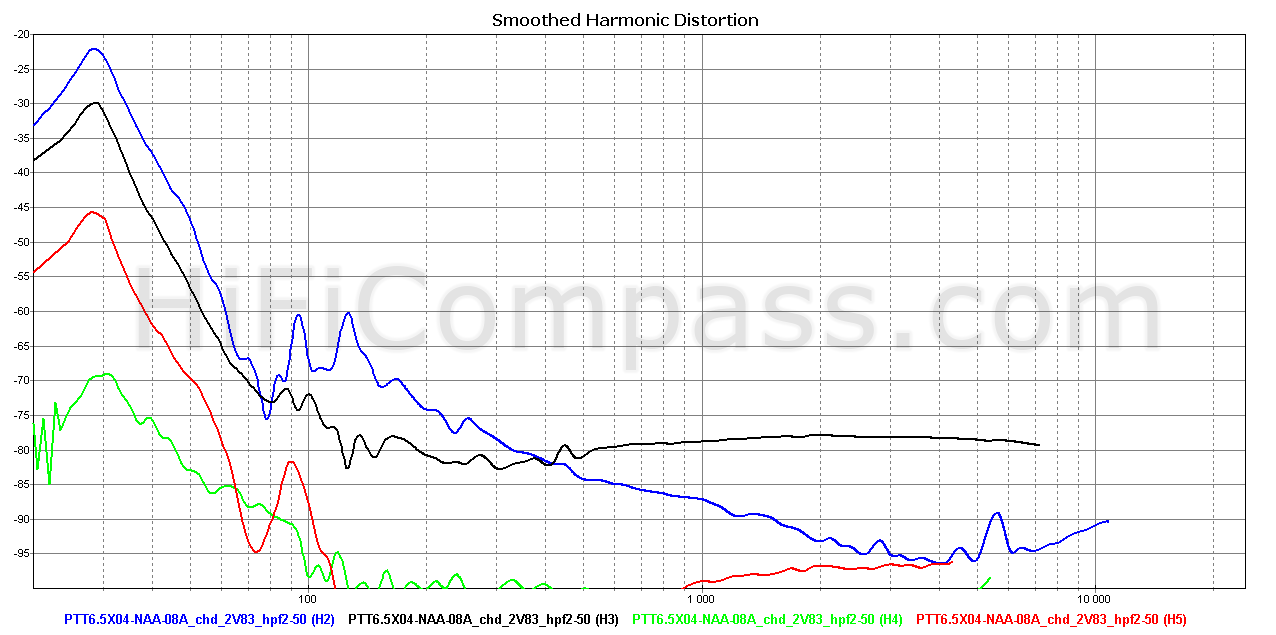

This type of measurement, despite its simplicity, is an excellent tool for assessing the linearity of a speaker motor. The above plots show the frequency dependences of the 2nd, 3rd, 4th and 5th harmonics of the voice coil current at 2.83 and 8 volt. To limit the speaker overload in terms of the membrane displacement when measuring harmonic distortion, a second-order Butterworth type high-pass filter with a cutoff frequency of 50 Hz was used.
Voice coil current nonlinearity is the direct nonlinearity of the mechanical force driving the speaker cone, since this force is related to the current by a simple relationship F=B*L*I, where B is the magnetic field strength, L is the length of the voice coil wire inside the magnetic gap and I is the current. So, in principle, it is practically impossible to obtain sound pressure distortion lower than current distortion in the frequency range where the contribution of the motional nonlinearity becomes insignificant.
The fourth and fifth harmonics above 100 Hz are out of the question. The second harmonic of the current also depends linearly on the voltage level, as well as its manifestation in sound pressure. The level of the third harmonic above 150 Hz depends on the input voltage much weaker. Below 120 Hz, due to the increase in the membrane excursion, a sharp increase in harmonics of all orders begins.
I would rate the harmonic distortion of the voice coil current as "very low".
The intermodulation distortion measurement is one of way of to analyze the device non-linearity. It is not an alternative, but an additional method and allows you to identify the spectral components of the inharmonious structure, which are much more harmful for high-quality sound reproduction and to which our hearing is more sensitive.
There is a very good article of Bruno Putzeys - "Distortion, The Sound That Dare Not Speak Its Name", where he very well describes the mechanism and origins of the intermodulation distortions in a midwoofer, as well as introduces one interesting testing experiment that everyone can do. Its essence is the simultaneous supply of a musical signal to a midwoofer such as singing (rather than a speech, for better audibility of the effect) male or female vocals, or a violin, clarinet, flute, and sine wave signal with frequency of 30 Hz, the level of which can be adjusted. The sine signal causes a large cone excursion, which leads to the appearance of non-linearity of the suspension and the force factor. The suspension nonlinearity leads only to the appearance of harmonic distortions of the 30 Hz sine signal and does not affect the reproduction of midrange, while the modulation of the force factor leads to a change in the sensitivity of the speaker for midrange frequencies. This changing is manifested in the amplitude modulation of the voice notes with 30 Hz sine. Try this experiment yourself and you will be very surprised how audible intermodulation distortions are and how they grow with an increase of the low-frequency component. Perhaps this will be a great discovery for you.
For testing I chose the frequencies of 30 Hz and 255 Hz. With this ratio (1:8.5) the contribution of the Doppler distortion is not yet dominant and the contribution of amplitude modulation can still be observed. In addition, this is a very realistic situation that occurs in both two-way and three-way systems. The measurements were performed for different 30 Hz cone excursions and their conditions are indicated in the lower left corner of each plot. By various colors are indicated:
- test frequencies
- 2nd order harmonic distortion components for the test frequencies (2nd HD)
- 3rd order harmonic distortion components for the test frequencies (3rd HD)
- 2nd order intermodulation distortion amplitude (IMA2)
- 3rd order intermodulation distortion amplitude (IMA3)
However, in these plots products of the motor nonlinearity are mixed with products of inevitable frequency modulation of the Doppler effect. How do you define who is who? We can analytically estimate the level of the first pair of the side Doppler components using the following formula [http://www.linkwitzlab.com/frontiers.htm#J]:
For 9 mm = -33.5 dB
Step response
Excellent step response - fast rise, monotonous fall, no overshoot. It could be called absolutely ideal if it were not for the oscillatory process sitting on the top of it, caused by membrane resonances. After filtering in the crossover, there will be no trace of it, so you should not take this waviness to heart.
Waterfall
The waterfall shows the same effects as a step response, in addition exposing hidden resonances that are difficult to see in other types of measurements. In this case, no new problematic resonances were found.
We see a very fast decay during the first 500 µs and a monotonous, uniform fading over the entire frequency range up to 3 kHz. It's good.
The main membrane resonance at 5.3kHz is of very high Q, resulting in a very long ridge extending well beyond the first three milliseconds. You can’t leave it unattended and you have to neutralize it either with a high-order low-pass filter or with a narrow-band notch.
The 9.7 kHz ridge is not so dangerous and is located further in frequency, so the need for selective suppression of it will depend on the steepness of the main low-pass filter.
As usual, after completing the measurements, I started listening to the midwoofer in the test baffle on a wide variety of musical material. No filtering was applied to the speaker, except that the frequency response was equilized at 5.3kHz and 9.7kHz by a digital signal processor.
Thanks to a low resonance frequency (30Hz) supported by a huge linear stroke (10mm) and very low distortion, the woofer can dig really deep. You can find many 6" midwoofers with similar resonance frequency and 6-7mm linear stroke, but I can assure you their lower bass quality will be definitely worse. The PTT6.5X04-NAA-08 simultaneously with heavy work on a large amplitude at the lowest frequencies does not lose grip and articulation on the middle and upper bass. Bass completely retains the right structure, density, does not increase its tonality and not become thinner due to the enrichment by a forest of parasitic harmonics. It is clean and accurate, and this is due to the extremely low intermodulation distortion. There is no audible distortion at any volume level. Beyond the maximum allowable input signal you will simply hear the voice coil bump on the magnet system - the exact command for you to decrease the volume level. The extremely low aerodynamic noise of the moving system is impressive, even with an amplitude of 10 mm at 30 Hz.
Due to the low distortion and lack of second harmonic dominance in the distortion spectrum, I would characterize the bass as very accurate, true and analytical. It makes it possible to hear the bass exactly as it is, without false embellishment. The bass is not "fat" and not bloated, not sluggish, but on the contrary - dense, tenacious and firm, i.е. having a good attack and well-defined temporal contours.
The mid and upper midrange are very clean, transparent, contrasting and dynamic. Their transparency surprises and allows you to hear new nuances on old well-known recordings and not only hear musical instruments, but literally see them. It's worth a lot. While listening, the feeling of lightness, ease and naturalness of sounding did not leave me.
Complex classical orchestral music sounded very clear and with good separation of musical instruments. It was the same with rock music, from hard rock to thrash metal, without a hint of "porridge".
But, perhaps, the new midwoofer coped best with electronic and dance music (EDM) - it sounded very driving, energetic, lively, transparent, with excellent conveying of rhythm.
Compared to the paper version, the overall timbre of the aluminum version is drier, more analytical and less colorful, poorer in halftones. There is nothing new or surprising here, this is a feature of absolutely every speaker with aluminum membrane that I have heard.
I've never been a big fan of aluminum cone speakers, no matter what type they were - bass, midbass, midrange or tweeter. Somehow I gravitate towards the emotionality and timbre palette of the "paper" cone, even to the detriment of transparency and clarity. However, I was especially impressed by the new PURIFI PTT6.5X04-NAA-08 midwoofer, which expanded my understanding of the possibilities of "aluminum" speakers. This is by far the best aluminum mid-woofer I've ever heard and far superior to the familiar Dayton Audio RS180-4, SEAS L18RNX/P, SB Acoustics SB17NBAC35-8.
"How to use" recommendations
The table shows the main parameters of the paper and aluminum versions of the speakers, as well as the recommended volume and port tube parameters for the Bass Reflex enclosure. The diameters of the port tubes were determined taking into account the equality of the maximum internal air velocities and the realization of the full potential of the air volume linear displacement of the midwoofers without noticeable compression:
| Parameter | PTT6.5X04-NFA-01 | PTT6.5X04-NAA-08 |
| Fs, Hz | 30 | 32 |
| Qts | 0.27 | 0.35 |
| Vas, litre | 25.9 | 20.5 |
| Mms, gram | 26.7 | 29.8 |
| S, dB/V*1m | 88.7 | 86.8 |
| BL, N/A | 8.1 | 7.8 |
|
Optimal volume of |
13.7 | 22 |
|
Recommended size |
62/370 | 70/350 |
| Low frequency limit (-3 dB) F3, Hz |
54 | 40.6 |
As you can see, the paper and aluminum versions differ not only in the material of the membranes, but also in the Thiel/Small parameters, the optimal volume of the enclosure and the achievable lower frequency limit.
The optimal enclosure volume for the paper version is 13.7 liters, into which you need to manage to squeeze a 370 mm long port tube, which seems not entirely realistic. Therefore, the Bass Reflex design is largely formal for the paper version, the correct implementation of which is associated with significant difficulties. Practically, the only solution (I don't consider options with active low-frequency correction) is the Passive Radiator design, which entails a significant increase in the cost of the design.
In the aluminum version, the PURIFI's engineers chose a slightly different compromise between the main parameters, namely, they sacrificed a little the sensitivity and dimensions of the optimal enclosure in order to achieve a lower cutoff frequency and the possibility of practical implementation of the Bass Reflex design. Judge for yourself, it will not be difficult to place a port tube 350 mm long in a 22-liter box. I think this is a very important feature of the aluminum version, which will undoubtedly help expand the applicability of the midwoofer.
What is the price and where to purchase it?
You can buy PTT6.5X04-NAA-08 midwoofers both directly from PURIFI and in various online stores. The retail price is in the range of €330/unit excluding VAT.
- https://purifi-audio.com/ptt6-5x04-naa-08/
- https://www.soundimports.eu/en/purifi-ptt65x04-naa-08.html
- https://solen.ca/products/speakers/home-speakers/woofers/purifi-audio-pt...
Summary
The testing confirmed the almost complete compliance of all measured parameters and characteristics with the datasheet, with the exception of sensitivity, which turned out to be 0.8 dB lower than the declared value. The consistency of parameters from sample to sample is excellent.
Up to this point my reference in terms of harmonic and intermodulation distortion was the PTT6.5W08-01B (PTT6.5X08-NFA-01) with a paper membrane, but after today's review, the palm goes to a new model with an aluminum membrane PTT6.5X04-NAA-08.
It is the best aluminum cone 6" midwoofer I've ever heard.
So, what can be noted:
- Low sensitivity - 86 dB/2.83 volt*1m
- Very long linear stroke - 9.8 mm per one way
- Really working PURIFI Neutral Surround technology
- Rigid aluminium membrane
- Very low harmonic distortion
- Very low intermodulation distortion
- Excellent production quality
- Very flat and smooth frequency response
- Upper frequency limit up to 3 kHz
- Not only theoretical, but also a real practical possibility of using in the Bass Reflex design of the enclosure
You can get more information about the measurement results here
Yevgeniy Kozhushko/25.03.2022
CONTACTS
- Ukraine
- (+380) 95 904 7827
- hificompass@gmail.com
LAST NEWS
-
27 Mar 2025
-
04 Mar 2025
-
25 Feb 2025
-
10 Feb 2025
